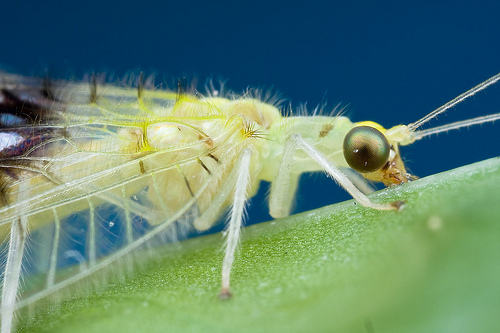New Species Discovered on Flickr
There’s a very cool story on NPR about “A New Species Discovered … On Flickr“. A entomologist was looking at some photos, and saw a bug he’d never seen. Check out the photographer’s site or Flickr pages. The paper is “A charismatic new species of green lacewing discovered in Malaysia (Neuroptera, Chrysopidae):
the confluence of citizen scientist, online image database and cybertaxonomy:”
The online images were then randomly examined by the senior author (SLW) who determined that this distinctive species was not immediately recognizable as any previously described species. Links to the images were forwarded to additional experts in chrysopid taxonomy to elicit comment on its possible taxonomic identity. After extensive discussion it was concluded that the species was likely new to science but its generic placement inconclusive based solely upon the images at hand.
I find it fascinating that the distinction of a new species is keyed on a morphological difference like this. While I know nothing about the chryopidae, and this is just a lay comment, but substantially larger variations occur in dogs without driving the claim of a new species. Does anyone know what makes for a new chryopid?
Photo by Kurt, aka Hock Ping Guek.

This is where being married to a biologist helps… the short answer is that it is still mostly qualitative rather than quantitative.
Traditionally (as in Darwin’s day) in biology morphology was the primary factor, but your dog example points out how superficial that is. Modern biology has tried to define it in terms of genetic uniqueness and reproductive isolation (i.e. mixing two species may result in a hybrid, but will NOT result in an offspring that itself may reproduce), morphology/traits, and geographic isolation, while controlling for large trait variability within a species (dog breeds – there are a huge number of superficial features within the species, but all are controlled by the same genes more or less so reproductive viability remains; they also may effect size, hair, color, etc. but don’t form fundamentally different organ organization). There are a lot of “species” grandfathered from the old days that today probably wouldn’t be there own species, and there are also concepts of pseudo-species and sub-species to confound the definitions.
The morphology/traits remains because small, compatible changes in the genome can result in wildly different end results. As an example, our own genome contains evidence that humans had interbred with both bonobos and Neanderthal, implying a lack of both reproductive isolation and geographic isolation. That said, the organization of each species’ physiology is markedly different (and not just superficially as with most dog breeds) despite the genetic compatibility (plus, humans are conceited and many already have a hard time accepting shared ancestry with apes, so we HAVE to be our own special flower).
That said, a biologist simply looking at a picture on flickr and going “new species” is really stretching – differences in appearance are the FIRST step in determining a new species, rather than the last